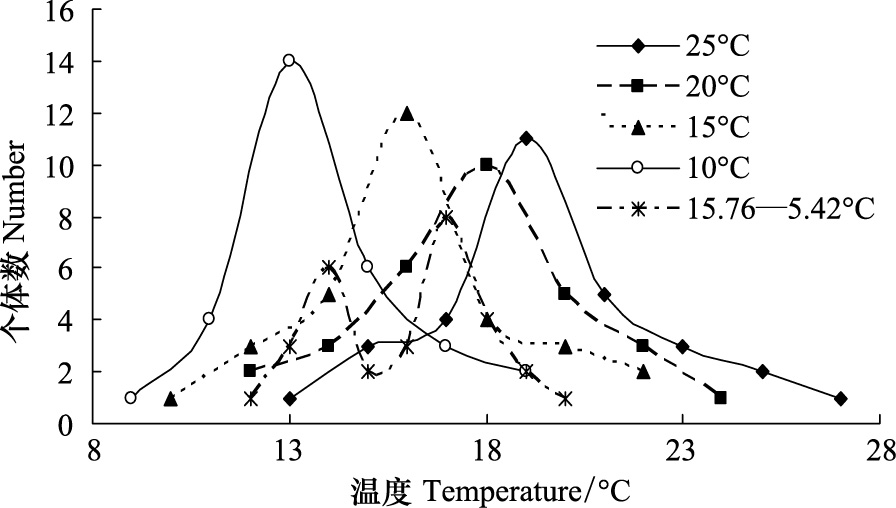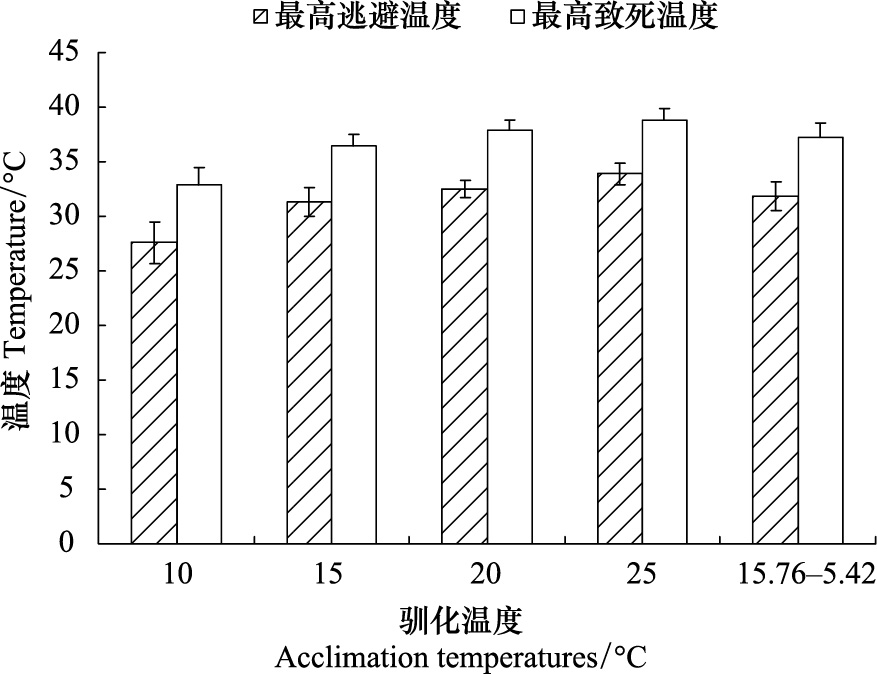文章信息
- 王立志
- WANG Lizhi
- 恒温和变温驯化对大蟾蜍蝌蚪热耐受性的影响
- The effects of constant and variable thermal acclimation on thermal tolerance of the common giant toad tadpoles (Bufo gargarizans)
- 生态学报, 2014, 34(4): 1030-1034
- Acta Ecologica Sinica, 2014, 34(4): 1030-1034
- http://dx.doi.org/10.5846/stxb201209271356
-
文章历史
- 收稿日期:2012-9-27
- 修订日期:2013-12-29
2. 陕西学前师范学院生物科学与技术系, 西安 710061
2. Department of Biological Science and Technology, Shaanxi Xueqian Normal University, Xi'an 710061, China
外温动物主要利用外热源,选择活动时间和冷热斑块之间穿梭等行为途径进行体温调节,以维持相对较高且稳定的体温[1]。环境温度通过影响体温而影响动物的生理功能和行为表现[2, 3]。过高或过低的体温对动物有害甚至能导致其死亡,在极端高、低体温之间,相对较高的体温有利于动物较好地表达其生理功能和行为表现[1, 2, 3, 4]。
驯化传统上被定义为,在实验室条件下,动物针对一个单一因子变量的改变所产生的生理机能上的补偿性调整[5]。国际生理科学协会(International Union of Physiological Sciences,IUPS)下属的热力学委员会2003给驯化的定义是,驯化是有机体发生的一些生理和行为上的变化,这些生理和行为上的变化能够减少由实验诱导的特定气候因子的刺激性变化带来的不良影响或能够提高动物对这些不良影响的耐受性。生理学家一般认为,所有由驯化产生的表型上的补偿性变化能够提高有机体在诱导这些补偿性变化发生的环境中的生理机能或适合度[6]。
自Mendelssohn[7]对动物热适应的开拓性研究以来,已有一系列温度梯度装置被用来研究各种动物的热偏爱。然而,很少有对不同生长阶段两栖类的热偏爱方面的研究报道。有关恒温下中国林蛙和大蟾蜍的蝌蚪的热适应及其驯化温度对其的影响已有报道[8]。然而关于在自然环境下生长发育的大蟾蜍蝌蚪的热适应还没有报道。
大蟾蜍(Bufo gargarizans)是一种具有较高的营养价值和药用价值的两栖类动物,其经济价值很高。本文研究了在恒温和变温下大蟾蜍蝌蚪的热适应性,得到了其在不同温度条件下的最适温度、最高逃避温度和最高致死温度,为实现人工控制其在野外环境下的生长发育,为大蟾蜍蝌蚪的人工饲养提供新的理论指导。
1 材料与方法 1.1 研究材料大蟾蜍卵采自秦岭北麓滈河边的池塘中,滈河位于N:36°06′916″,E:108°54′455″,海拔420m,池塘的水温约为0—5 ℃,pH值为6.6—6.8。试验用水均为采自原生境中的天然河水,pH值为6.8。试验容器为半径15.0cm 的塑料盆,高约20.0cm。将采集的大蟾蜍卵分别放在4个相同的盛有pH值为6.6—6.8天然河水的塑料盆中,每个盆中均投放100枚(均来自同一母体),水深10.0cm。与采集当天把装有大蟾蜍卵的塑料盆分别放在25、20、15 ℃和10 ℃的恒温恒湿培养箱(LRH-250-S)中孵化,湿度均为70%,光照14L ∶ 10D。将孵化出的大蟾蜍蝌蚪仍然分别放在25、20、15 ℃和10 ℃的恒温恒湿培养箱中驯化2周。在驯化期间,用鱼饲料喂养,每天投食和换水1次,并清除水中杂质。在野外环境下生长的大蟾蜍蝌蚪的水温变化范围为15.76—5.42 ℃,平均水温为10.59 ℃。
1.2 研究方法将在不同温度下驯化2周后的大蟾蜍蝌蚪和在野外环境下生长2周的大蟾蜍蝌蚪分别用温度梯度装置测量记录它们的最适温度、最高逃避温度和最高致死温度。温度梯度装置主要由温梯金属盒(100 cm ×10 cm ×5 cm)、冰水浴和恒温水浴构成[9]。在由温梯金属板形成的盒子中加入2cm深的蒸馏水,形成一个水槽结构。水槽一端连接在恒温水浴锅上(温度为60 ℃),另一端置于0 ℃的冰水中,以便使槽内的蒸馏水形成一系列的温度梯度。用热敏电偶测定蒸馏水的温度。蝌蚪在水槽中掉转身体逃避时所在位置的温度即为逃避温度,如果蝌蚪没有立即逃离但已经出现异常行为(如表现为急躁、乱撞、紧张等)时所在点的温度也被认为是其逃避温度,在5min的时间内停留或出现频率(频率是指单个个体在5min内出现的位置的频率)最高的位置的温度范围即为最适温度范围;致死温度的测量采用逐渐升高水温直至蝌蚪死亡时的温度值。每个驯化温度下用来测量的蝌蚪个数均为30尾。整个试验过程中,每次试验只用一个大蟾蜍蝌蚪,测量其最适温度、最高逃避温度或最高致死温度。整个试验的操作时间是在8:00到10:00,试验时环境温度为:(16±1)℃。
1.3 数据处理驯化反应比率(The acclimation response ratio,ARR)通过不同温度驯化后的最适温度、逃避温度和致死温度变化量除以驯化温度变化量求得[10]。驯化反应比率用来估计热驯化对最适温度、最高逃避温度和最高致死温度的影响程度。驯化反应比率的数值越大表明驯化温度对动物的影响越大,反之亦然。驯化反应比率的计算方法如下:
最适温度的ARRs =(25 ℃下驯化的最适温度-10 ℃下驯化的最适温度)/(25 ℃—10 ℃);
最高逃避温度的ARRs=(25 ℃下驯化的最高逃避温度-10 ℃下驯化的最高逃避温度)/(25 ℃—10 ℃);
最高致死温度的ARRs=(25 ℃下驯化的最高致死温度-10 ℃下驯化的最高致死温度)/(25 ℃—10 ℃)。
数据统计前,对所有的数据进行正态性检验。在SPSS10.0 中用线性回归和单因素方差分析(one-way ANOVA)对数据进行统计处理。描述性统计值均用平均值±标准差表示,显著性水平设在α=0.05。
2 结果 2.1 大蟾蜍蝌蚪的最适温度在不同的驯化温度下,大蟾蜍蝌蚪有不同的最适温度(平均值)和最适温度范围(表 1,图 1)。单因素方差分析表明在不同的驯化温度下,大蟾蜍蝌蚪的最适温度有着显著的差异(F =13.33; P <0.001; d f=4; N =150)。在恒温条件下,随着驯化温度的升高大蟾蜍蝌蚪的最适温度和最适温度范围都在增加。在恒温条件下,驯化温度和大蟾蜍蝌蚪的最适温度存在线性关系,其表达式为:Y =0.3074X +12.053,r =0.982,P <0.01,N =120;Y表示最适温度,X表示驯化温度。
| 驯化温度Acclimation temperature/℃ | |||||
| 10 | 15 | 20 | 25 | 15.76—5.42 | |
|
最适温度/℃
Preferred temperatures | 14.8±2.9 | 17.2±3.8 | 18.1±3.5 | 19.6±2.5 | 13.9± 1.7;
17.2±1.4 |
|
最适温度范围/℃
Range of preferred temperatures | 11—15 | 14—18 | 16—20 | 17—21 | 13—15; 15—18 |

|
| 图1 不同驯化温度下的大蟾蜍蝌蚪的最适温度 Fig. 1 Preferred temperatures of the common giant toad tadpoles in different acclimation temperatures |
10、15、20 ℃和25 ℃恒温驯化2周的大蟾蜍蝌蚪的最高逃避温度分别为:(27.6±1.9),(31.3±1.3),(32.5±0.8),(33.9±1.0) ℃;在15.76—5.42 ℃变温驯化下的大蟾蜍蝌蚪的最高逃避温度为(31.8±1.3) ℃(图 2)。单因素方差分析说明在不同的驯化温度下,大蟾蜍蝌蚪的最高逃避温度也有显著的差异(F=176.606; P <0.001; df=4; N =150)。在恒温条件下,随着驯化温度的升高大蟾蜍蝌蚪的最高逃避温度都在增加。在恒温条件下,驯化温度和大蟾蜍蝌蚪的最高逃避温度存在线性关系,其表达式为:Y =0.4109X + 24.31, r =0.954,P <0.01,N =120;Y表示最高逃避温度,X表示驯化温度。
2.3 大蟾蜍蝌蚪的最高致死温度10、15、20 ℃和25 ℃恒温驯化2周的大蟾蜍蝌蚪的最高致死温度分别为:(32.9±1.6),(36.5±1.0),(37.9±0.9),(38.8±1.1)℃;在15.76—5.42 ℃变温驯化下的大蟾蜍蝌蚪的最高致死温度为(37.2±1.3) ℃(图 2)。单因素方差分析说明在不同的驯化温度下,大蟾蜍蝌蚪的最高致死温度也有显著的差异(F =178.917; P <0.001; df=4; N =150)。在恒温条件下,随着驯化温度的升高中大蟾蜍蝌蚪的最高致死温度都在增加。在恒温条件下,驯化温度和大蟾蜍蝌蚪的最高致死温度存在线性关系,其表达式为:Y=0.3847X + 29.774,r=0.954,P <0.01,N =120;Y表示最高致死温度,X表示驯化温度。
2.4 驯化反应速率(ARRs)驯化温度对大蟾蜍蝌蚪的最适温度施加的影响要比最高逃避温度和最高致死温度的影响小(表 2)。大蟾蜍蝌蚪最适温度的ARRs比最高逃避温度的低0.1,比最高致死温度的低0.07。
3 讨论从原生动物到哺乳类,所有动物都会逃避极端 低温和极端高温,表现出偏爱温度适中区。在一个

|
| 图2 不同驯化温度下的大蟾蜍蝌蚪的最高逃避温度和最高致死温度 Fig. 2 High avoidance temperature and high lethal temperature of the common giant toad tadpoles in different acclimation temperatures |
|
种名
Name of Species | 驯化温度
Acclimation temperature | 最适温度的ARRs
ARRs of PT* | 最高逃避
温度的ARRs ARRs of HAT* | 最高致死
温度的ARRs ARRs of HLT* |
| *PT:Preferred temperature; HAT:High avoidance temperature; HLT:High lethal temperature | ||||
|
大蟾蜍蝌蚪
s The common giant toad tadpoles | 10 ℃/25℃ | 0.32 | 0.42 | 0.39 |
有温度梯度的热环境中,能够运动的动物都会向一个较窄的最适温度范围集中。这种现象称作行为热调节或温度偏爱[11]。这种最终适温被赋予以下定义:在一个温度梯度中,一个给定种的所有个体将最终都会向某一温度聚集,而不管它们在被置于这一存在温度梯度的热环境之前的热经历如何,这一温度称作最终适温[12]。热偏爱(thermal preference)反映了诸如新陈代谢、运动、繁殖和生长等生理过程所要求的最适温度[13, 14, 15, 16, 17, 18]。事实上,动物常常将诸如生长、繁殖和觅食等能够提高适合度的活动集中在一个较窄的温度范围内[19, 20]。显然,动物在最适温度范围内能最有效地完成那些能提高适合度的活动。换句话说,任何偏离最适温度的温度环境都会给旨在提高适合度的活动的表达带来不利的影响。有关上、下限临界温度的研究给动物提供了一个生态指标[21, 22]。
任何随时间呈正弦轨迹变化的环境因子,如温度的昼夜变化,都会呈现两峰或三峰分布[23]。根据最适性模型,双峰环境实际上是具有同一标准误差的两个正常分布的混合体,这两个正常分布被一个峰间距所隔离。该模型预测,当呈双峰分布的温度的峰间距为17℃时将出现3个适合度峰值[24]。
在恒温条件下驯化的大蟾蜍蝌蚪的最适温度分布仅有一个峰值,而在自然变温环境下生长发育的大蟾蜍蝌蚪的最适温度分布出现两个峰值。这种现象可以通过驯化温度的波动来解释。经过恒温驯化的大蟾蜍蝌蚪只经历了一个稳定的温度驯化过程,因而它们的最适温度分布只有一个峰值,而那些经过变温驯化的大蟾蜍蝌蚪经历了由低到高再由高到低并以24h为周期的正弦轨迹式温度变化。较大的驯化温度范围产生较大的最适温度范围。较低的最适温度峰值对应于夜间较低的水温,较高的最适温度峰值对应于白天较高的水温。因此,在自然变温环境下生长发育的大蟾蜍蝌蚪的最适温度分布出现两个峰值,且最适温度范围也比在恒温条件下驯化的大蟾蜍蝌蚪的宽。
大蟾蜍蝌蚪的最高逃避温度可能代表了它们在自然环境中遭遇的温度变化范围。最高逃避温度远高于最适温度范围。这一结果符合最适性模型的另一个预测:动物能够进行正常活动的温度范围一般小于在任何一个世代内动物所经历的环境温度[24]。
最高致死温度较高于最高逃避温度,说明大蟾蜍蝌蚪能够耐受的极端高温范围较窄,但能够适应的温度范围却很宽。经过变温驯化后的大蟾蜍蝌蚪能够耐受较高的不利温度,这一结果也符合最适性模型预测:动物在变温环境中的温度耐受性高于其在恒温环境中的温度耐受性[24]。
不同的驯化温度显著影响大蟾蜍蝌蚪的最适温度、最高逃避温度和最高致死温度,其中对最适温度的影响最小,对最高逃避温度影响最大。
| [1] | Huey R B, Kingsolver J G. Evolution of thermal sensitivity of ectotherm performance. Trends in Ecology & Evolution, 1989, 4: 131-135. |
| [2] | Avery R A. Field studies of body temperature and thermo regulation//Gans C, Pough F H eds. Biology of the Reptilia Vo. l. 12. New York: Academic Press, 1982: 93-116. |
| [3] | Huey R B. Temperature, physiology and the ecology of reptiles. In: Gans C, Pough F H eds. Biology of the Reptilia Vo. l. 12. New York: Academic Press. 1982: 25-91. |
| [4] | Pough F H. The advantages of ectothermy for tetrapods. The American Naturalist, 1980, 115: 92-112. |
| [5] | Prosser C L. Environmental and Metabolic Animal Physiology: Comparative Animal Physiology, Wiley-Liss. 1991: 24-47. |
| [6] | Wilson R S, Franklin C E. Testing the beneficial acclimation hypothesis. Trends in Ecology & Evolution, 2002, 17 (2): 66-70. |
| [7] | Mendelssohn E. Ueber den Thermotropismus einzelner Organismen. Pflügers Arch. Ges. Physiol., 1895, 60: 1-27. |
| [8] | Wang L Z, Li X C, Sun T. Preferred temperature, avoidance temperature and lethal temperature of tadpoles of the Common Giant Toad (Bufo gargarizans) and the Chinese Forest Frog (Rana chensinensis). Chinese Journal of Zoology, 2005, 40(2): 23-27. |
| [9] | Wang L Z, Li X C. Effects of constant thermal acclimation on thermal tolerance of the Chinese Forest Frog (Rana chensinensis). Acta Hydrobiologica Sinica, 2007, 31(5): 748-750. |
| [10] | Claussen D L. Thermal acclimation in ambystomatid salamanders. Comparative Physiology and Biochemistry, 1977, 58A: 333-340. |
| [11] | Reynolds W W, Casterlin M E. Behavioral thermoregulation and the "final preferendum" paradigma. American zoologist, 1979, 19: 211-224. |
| [12] | Fry F E J. Effects of the environment on animal activity. University of Toronto Studies, Biological Services, 1947, 68: 1-62. |
| [13] | Jobling M. Temperature tolerance and the final preferendum-rapid methods for the assessment of optimum growth temperatures. Journal of Fish Biology, 1981, 19: 439-455. |
| [14] | Kellog R L, Gift J J. Relationship between optimum temperatures for growth and preferred temperatures for the young of four fish species. Transactions of the American Fisheries Society, 1983, 112: 424-430. |
| [15] | McCauley R W, Casselman J M. The final preferendum as an index of the temperature for optimum growth in fishes. World Symposium on Aquaculture in Heated Effluents and Recirculation Systems, 1981, 2: 81-93. |
| [16] | Hadfield S. Observations on body temperature and activity in the toad Bufo woodhousei fowleri. Copeia, 1996, (4): 581-582. |
| [17] | Smith G C. Ecological energetics of three species of ectothermic vertebrates. Ecology, 1976, 57: 252-264. |
| [18] | Lillywhite H B. Behavioural thermoregulation in the Bullfrog Rana catesbiana. Copeia, 1970, (1): 58-168. |
| [19] | Brett J R. Some principles in the thermal requirements of fishes. The Quarterly Review of Biology, 1956, 31: 75-86. |
| [20] | Hutchison V H. Factors influencing thermal tolerance of individual organisms//Esch W G, McFarland W R, eds. Thermal Ecology Ⅱ. US National Technical Information Service, Springfield, 1976: 10-26. |
| [21] | Andrewartha H G, Birch L C. The distribution and abundance of animals. Chicargo, USA: University of Chicargo Press, 1954: 26-235. |
| [22] | Magnuson J J, Crowder L B, Medvick P A. Temperature as an ecological resourse. American Zoologist, 1979, 19: 331-343. |
| [23] | Curry G L, Feldman R M. Mathematicl foundations of population dynamics. Texas A&M University Press, College Station, 1987: 35-46. |
| [24] | Gilchrist G W. Specialists and generalists in changing environments. Ⅰ. fitness landscapes of thermal sensitivity. The American Naturalist, 1995, 146(2): 252-270. |
| [8] | 王立志,李晓晨,孙 涛. 中国林蛙蝌蚪和大蟾蜍蝌蚪的最适温度、逃避温度和致死温度. 动物学杂志,2005,40(2): 23-27. |
| [9] | 王立志,李晓晨. 恒温驯化对中国林蛙热耐受性的影响. 水生生物学报,2007,31(5): 748-750. |
 2014, Vol.34
2014, Vol.34




